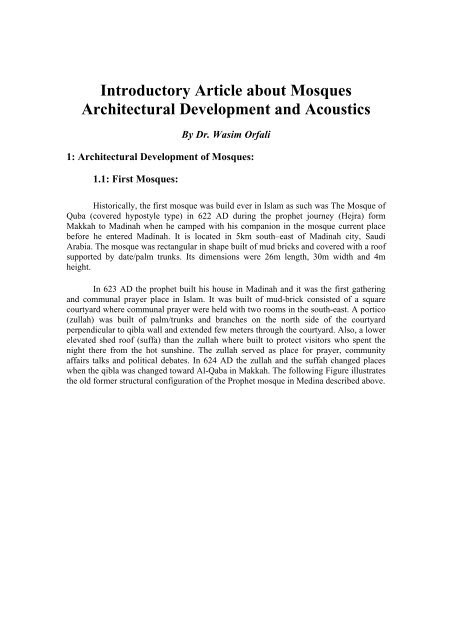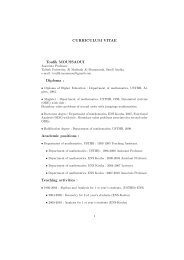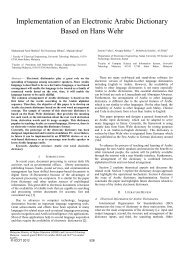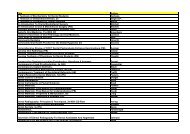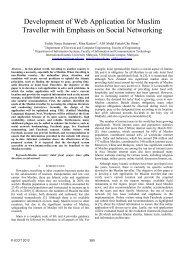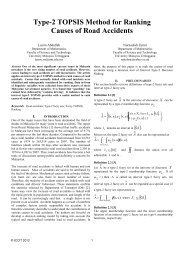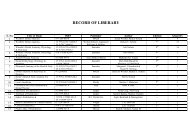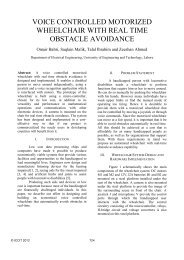Introductory Article about Mosques Architectural Development and ...
Introductory Article about Mosques Architectural Development and ...
Introductory Article about Mosques Architectural Development and ...
Create successful ePaper yourself
Turn your PDF publications into a flip-book with our unique Google optimized e-Paper software.
<strong>Introductory</strong> <strong>Article</strong> <strong>about</strong> <strong>Mosques</strong><br />
<strong>Architectural</strong> <strong>Development</strong> <strong>and</strong> Acoustics<br />
By Dr. Wasim Orfali<br />
1: <strong>Architectural</strong> <strong>Development</strong> of <strong>Mosques</strong>:<br />
1.1: First <strong>Mosques</strong>:<br />
Historically, the first mosque was build ever in Islam as such was The Mosque of<br />
Quba (covered hypostyle type) in 622 AD during the prophet journey (Hejra) form<br />
Makkah to Madinah when he camped with his companion in the mosque current place<br />
before he entered Madinah. It is located in 5km south–east of Madinah city, Saudi<br />
Arabia. The mosque was rectangular in shape built of mud bricks <strong>and</strong> covered with a roof<br />
supported by date/palm trunks. Its dimensions were 26m length, 30m width <strong>and</strong> 4m<br />
height.<br />
In 623 AD the prophet built his house in Madinah <strong>and</strong> it was the first gathering<br />
<strong>and</strong> communal prayer place in Islam. It was built of mud-brick consisted of a square<br />
courtyard where communal prayer were held with two rooms in the south-east. A portico<br />
(zullah) was built of palm/trunks <strong>and</strong> branches on the north side of the courtyard<br />
perpendicular to qibla wall <strong>and</strong> extended few meters through the courtyard. Also, a lower<br />
elevated shed roof (suffa) than the zullah where built to protect visitors who spent the<br />
night there from the hot sunshine. The zullah served as place for prayer, community<br />
affairs talks <strong>and</strong> political debates. In 624 AD the zullah <strong>and</strong> the suffah changed places<br />
when the qibla was changed toward Al-Qaba in Makkah. The following Figure illustrates<br />
the old former structural configuration of the Prophet mosque in Medina described above.
Shed Roof (Suffa)<br />
Prophet’s Residence<br />
Figure 1 The old former structural configuration of the Prophet mosque in Medina.<br />
The Holy Mosque in Makkah was not converted to a mosque at that time. It was<br />
an open air temple for the Quraysh triple <strong>and</strong> the people of Makkah who forced the<br />
Prophet to leave Makkah.<br />
1.2: Emerging of Basic Elements of <strong>Mosques</strong>:<br />
A Portico (Zullah)<br />
Courtyard<br />
<strong>Mosques</strong> are places of worship used for prayer, public speaking, preaching,<br />
lecturing, <strong>and</strong> Quran recitations. All activities performed in mosques are related to<br />
speech audibility <strong>and</strong> intelligibility. Compared to Churches, a good underst<strong>and</strong>ing of the<br />
speech <strong>and</strong> Quran recitation is required. Therefore, the design of their acoustical features<br />
<strong>and</strong> basic elements that are related to the acoustical behavior requires careful<br />
consideration if good listening conditions are to be achieved. In old churches,<br />
intelligibility of sound was not important while all the activity inside the church was<br />
carried in Latin language <strong>and</strong> the worshippers was asked only to repeat the prayers but<br />
not forced to underst<strong>and</strong>. On the other h<strong>and</strong>, Quran recitation in prayer, public speaking,
preaching <strong>and</strong> lecturing all require high level of intelligibility while all these activity are<br />
carried in Arabic language <strong>and</strong> have to be understood by the worshippers.<br />
Prophet Mohammed Mosque formed a model for the subsequent mosques<br />
throughout the Islamic world in its combination of basic elements (Qibla wall, Mihrab,<br />
Minaret, Minbar). These mosques have been influenced by the subsequent civilizations in<br />
respect of architectural form, space, construction system, <strong>and</strong> building materials. These<br />
materials have evolved <strong>and</strong> developed to a significant <strong>and</strong> variable extent in different<br />
parts of the Islamic world. The main functions of each of the basic element are still the<br />
same up to nowadays.<br />
Mihrab literally means “praying niche”. It is the most important feature in the<br />
mosque <strong>and</strong> it’s the center point of the qibla wall. It is semicircular in plan having a<br />
semicircular arched top all inserted in the qibla wall. It indicates the direction of prayer<br />
<strong>and</strong> its idea <strong>and</strong> design were inherited from the prophet mosque when after his death<br />
people marked the place where he used to st<strong>and</strong> to lead prayer by a stone afterward the<br />
stone was replaced by a Mihrab. The second important feature is called Qibla wall<br />
literally means “facing wall”. It is the wall facing Makkah <strong>and</strong> it’s the most decorated<br />
part of any mosque. This wall contains a Mihrab in its center <strong>and</strong> a the third element<br />
called Minbar ,commonly an elevated floor to the right of the Mihrab, as illustrated in<br />
Figure 2 <strong>and</strong> Figure 3.Unlike in Holy Haram in Makkah, worshippers form parallel lines<br />
to the qibla wall while they are in Group Prayer mode (as will be described later in<br />
subsequent article). The qibla wall perpendicular to the imaginary line that point to Al-<br />
Qaba in Makkah. Such a wall is not exist in The Holy Haram in Makkah where<br />
worshippers surrounding <strong>and</strong> praying facing Al-Qaba. The last important feature is called<br />
Minaret. Minaret literally means “slender tower with balconies”. It was added to the<br />
basic element to ensure that the voice of the Muaddin (The person making the call for<br />
prayer (adhan)) could be heard at far away distances. This remarkable addition was in<br />
673 AD when Umayyad the governor of Egypt demolished the first mosque of Amr at<br />
Fustat which could no longer accommodate the growing number of worshippers <strong>and</strong><br />
replace it with a new design with four minaret that were inherited from the Syrian church<br />
towers according to the wishes of Califa Muawiya.<br />
No Mihrab or Minaret where provided in the original construction of the prophet<br />
house, but a wooden Minbar with three steps where added later to the main construction<br />
features where the Prophet can deliver the Friday speech (kutba) <strong>and</strong> daily speeches <strong>and</strong><br />
be more visible <strong>and</strong> audible to the worshippers when they are in large number. It was an<br />
important feature replacing the traditional way of leaning on one of his house palms to<br />
deliver daily speeches. Minbar became an essential piece of acoustical <strong>and</strong> visual tools to<br />
make the Imam voice heard better <strong>and</strong> to be more visible for a lager number of audience.<br />
The house was kept as mosque (courtyard type) where the prophet was buried after his<br />
death.
Figure 2 Mihrab of the Imam.<br />
All these basic elements (qibla Wall, Mihrab, Minbar, Minaret) are important in<br />
the mosques construction <strong>and</strong> design throughout the Islamic world. Figure 3 shows the<br />
above mentioned basic elements of the mosque <strong>and</strong> their orientations within the mosque<br />
(Minaret will be an external feature constructed as a square tower).
Back Door<br />
wall<br />
Praying Niche<br />
(Mihrab)<br />
Minbar Qibla Wall Prayers<br />
performing<br />
Figure 3.Basic elements of a mosque <strong>and</strong> there orientations within the mosque space (constructed<br />
using computer software).<br />
1.3: <strong>Mosques</strong> Classification:<br />
One set of criteria can not be used to make a general classification for mosques<br />
<strong>and</strong> churches in the same time. While Churches can be classified architecturally to two
mean groups <strong>and</strong> 6 subgroups, <strong>Mosques</strong> may be classified primarily according to their<br />
construction style to two main types. The reason for that is a different acoustical<br />
requirement as a result of different religious activity. <strong>Mosques</strong> might be classified as<br />
follow:<br />
Traditional <strong>Mosques</strong>:<br />
Traditional mosques are classified according to their architectural form <strong>and</strong><br />
configuration .Some of these mosques have an important religious value <strong>and</strong> their<br />
internal <strong>and</strong> external construction can not be manipulated to optimize the sound behavior.<br />
Traditional mosques come in three different styles as they were also presented in the life<br />
time of the prophet. First, covered Hypostyle Hall with a roof supported by trees palms.<br />
Hypostyle mosques usually built in modest dimensions for Daily prayer, local Friday<br />
prayer <strong>and</strong> local occasions. The second type called Courtyard Mosque with sheltered<br />
Haram which means “Protected portico” <strong>and</strong> a Sahn which means “Courtyard”. This<br />
type is used for Daily prayers, Friday Prayers <strong>and</strong> political debates to be held under the<br />
covered haram roof. Finally, the third style is called a Marked out Open Area used for a<br />
big congregational prayers <strong>and</strong> important Islamic occasions.
(a)
(b)
(c)
(d)<br />
Figure 4 (a)Old Airport Market out open Area Mosque in Jeddah, Saudi Arabia.(b)The Prophet’s<br />
Mosque in Madinah ,Saudi Arabia, Represents a Courtyard Mosque(c,(d)) Al-Abbas Mosque<br />
Restoration in Asnaf, Yemen , Represents a covered Hypostyle Mosque
Contemporary <strong>Mosques</strong>:<br />
This type can be classified according to their size <strong>and</strong> location in the community<br />
to four types each of them has additional separated area for female worshipers in the<br />
same floor or mezzanine floor.<br />
The first subtype is called Major l<strong>and</strong>mark structure. This type is architecturally<br />
designed to provide a “l<strong>and</strong>mark” fulfilling their social function(s).It dominates the<br />
townscape <strong>and</strong> affects the order of space in the urban environment. They can occupy<br />
more than 3000 worshippers <strong>and</strong> it is usually built by a government or a significant figure<br />
in the country like kings or princes.<br />
The second subtype is called Large state Mosque. This type of mosques are<br />
usually located in large cites as public l<strong>and</strong>marks area <strong>and</strong> can occupy between 1500-<br />
3000 worshippers. They are usually built by the state government expressing the<br />
commitments of the government to Islam.<br />
The third subtype is called Communities <strong>Mosques</strong>. These mosques are distributed<br />
through out the urban <strong>and</strong> the rural communities <strong>and</strong> they are used for Friday Prayers <strong>and</strong><br />
Daily Prayers. They may accommodate additional faculties like a library, meeting rooms,<br />
clinic, etc. They also can accommodate minimum 300 worshipers <strong>and</strong> maximum 1000<br />
worshipers.<br />
Finally, the last subdivision is called Small Local <strong>Mosques</strong>. They are of modest<br />
dimensions <strong>and</strong> relatively small number of worshipers (
prostrating, or sitting behind the Imam all looking toward the qibla wall , on the same<br />
floor level, aligned in rows parallel to the qibla wall with distances around 1.2 m apart<br />
between each line. Individual prayer can be described as having the same worshipping<br />
acts as the Group prayer, but performed individually.<br />
Figure 5.Two different religious modes, (a) sections showing congregations listening to the<br />
Friday speech (i.e. the preaching mode) <strong>and</strong> performing Daily individual or group prayer (i.e.,<br />
the prayer-performing mode), <strong>and</strong> (b) is a top-view plan showing the source–receiver path (i.e.<br />
Imam worshippers in group prayer performing)<br />
The second mode is Preaching mode where worshippers are seated on the floor in<br />
r<strong>and</strong>om rows listening to the Imam preaching or delivering the khutba (Friday Speech)<br />
while st<strong>and</strong>ing on the elevated Minbar floor. The Minbar floor height varies from one<br />
mosque to the other but usually is in the range of one to three meters above the mosque<br />
floor. The listening domain for seated worshipers is believed to be 0.8 m.
2.2: Room-Acoustic Parameters in <strong>Mosques</strong>:<br />
The study of mosque acoustics, with regard to acoustical characteristics, sound<br />
quality for speech intelligibility, <strong>and</strong> other applicable acoustic criteria, has been neglected<br />
in the last 50 years. Unfortunately, dealing with acoustic in mosques comes in a later<br />
stage after finalizing the construction of such buildings.<br />
There are some work have been done in the field of evaluating the acoustical<br />
parameter of mosques <strong>and</strong> former Byzantine churches in Turkey called CHARISMA<br />
project (Conservation of the Acoustical Heritage by the Revival <strong>and</strong> Identification of the<br />
Sinan's <strong>Mosques</strong> Acoustics) <strong>and</strong> they are dated back to the last 6 years[11,12]. In this<br />
project, acoustical measurements by means of objective identification <strong>and</strong> evaluation<br />
(measurements, calculations) , subjective identification <strong>and</strong> evaluation (psycho-acoustical<br />
surveys) <strong>and</strong> Acoustical simulation for three <strong>Mosques</strong> <strong>and</strong> three Byzantine Churches,<br />
namely the Sokullu, Selimiye, Süleymaniye, Ss. Sergius <strong>and</strong> Bacchus, Saint Irene <strong>and</strong><br />
Hagia Sophia have been conducted. Furthermore, Comparison between In-situ recordings<br />
<strong>and</strong> Auralizations for some of these <strong>Mosques</strong> <strong>and</strong> Byzantine Churches was, also, within<br />
the context of this project. Also, an investigation of the effect of the Byzantine churches<br />
architecture on the Sinan’s structural design was one of the main aims in this project.<br />
Some other research papers have been conducted in evaluating <strong>and</strong> treating the acoustical<br />
characteristics of individual mosques. A remarkable work has been done in evaluating<br />
<strong>and</strong> treating some acoustical parameters in King Abdullah Mosque in Amman, Jordan.<br />
The treatment pressure involved changing the wall material, carpet <strong>and</strong> doubling the<br />
window thickness to block the outside noise <strong>and</strong> increase intelligibility. Almost all of<br />
these last mentioned works <strong>and</strong> others that have been done in the field of evaluating the<br />
acoustical parameters of mosques (Traditional <strong>and</strong> contemporary mosques) evaluated the<br />
following parameters: RT60 (Reverberation Time for 60dB reduction of sound energy),<br />
STI (speech Transmission Index to evaluate intelligibility), EDT (Energy Decay Time to<br />
evaluate lack of absorption treatment <strong>and</strong> volume), S/N (Signal to noise ratio to get a<br />
better view of the background noise), Articulation index (to evaluate the intelligibility),<br />
D/R (Direct to reverberant ratio is another way to evaluate intelligibility) <strong>and</strong> Sound<br />
pressure Distribution (evaluating the installed sound system).<br />
All of these research papers concluded that the acoustic of contemporary mosques<br />
have to be dealt with in an earlier stages of the design to reduce the cost <strong>and</strong> time of the<br />
acoustical treatment <strong>and</strong> to get better acoustical characteristics in mosques.
2.3: Sound System in <strong>Mosques</strong>:<br />
The study of mosque acoustics, with regard to acoustical characteristics, sound<br />
quality for speech intelligibility, <strong>and</strong> other applicable acoustic criteria, has been neglected<br />
in the last 50 years. Unfortunately, dealing with acoustic in mosques comes in a later<br />
stage after finalizing the construction of such buildings.<br />
In literature, no series of development of acoustic in mosques that can be<br />
mentioned or traced back throughout the last century as it is the case in churches as have<br />
been mentioned earlier. Three techniques were used <strong>and</strong> worth mentioning in the field of<br />
mosques acoustics; the addition of the Mihrab which has concaved shape to ensure a<br />
more efficient sound reflection of the Imam voice toward the worshippers in the Group<br />
Prayer mode. The use of the Imam Minbar was in order to improve the maximum sound<br />
coverage distance inside the mosque. Also, the Minaret was introduced in 673 AD to<br />
ensure that the voice of the Muaddin (The person making the call for prayer (adhan))<br />
could be heard at maximum distance possible in the area around the mosque.<br />
Nowadays, after the rise of new modern Electro-Acoustical techniques good<br />
designed mosques by an acoustical expert are benefiting from them. Also, computerbased<br />
programs were helping in designing, analyzing <strong>and</strong> simulating the sound system<br />
behavior of mosques in a more efficient way. Although, these assisting tools have<br />
appeared, some mosques with an important religious <strong>and</strong> spiritual values are not<br />
benefiting from them the way they are suppose to. The People responsible <strong>about</strong> sound<br />
system insulation in mosques think that it will take only couple of speakers, wires <strong>and</strong><br />
amplifiers <strong>and</strong> it will sound “RIGHT”. That is why in most mosques designs we notice<br />
some common mistakes like using sphere speakers while the mosques is suffering from<br />
low level of intelligibility <strong>and</strong>/or a long reverberation time , insulting speakers in two row<br />
distribution without using delay boxes what results in echo <strong>and</strong> low level of intelligibility.<br />
Also, because of the wrong placing of speakers <strong>and</strong> microphones the phenomena of<br />
feedback is common in mosques. Furthermore, <strong>Mosques</strong> are, in general, rectangular in<br />
shape with a lot of parallel walls <strong>and</strong> a central dome with several smaller ones; such a<br />
construction system is very problematic where generating of st<strong>and</strong>ing waves (as a result<br />
of parallel walls) is a fact <strong>and</strong> sound focusing (as a result of the domes) is possible. Both<br />
of the last mentioned design features are not dealt with as an acoustical concerns yet (<strong>and</strong><br />
as a main cause of a non even distribution of sound level) in most of the newly installed<br />
sound systems.<br />
Also, most of the modern designed mosques <strong>and</strong> some of the old<br />
“Traditional” large untreated volumes have sound-reflecting finish materials on all<br />
surfaces, except the floor area which is usually carpeted. They have wooden doors <strong>and</strong><br />
large single glazed windows. Noise level is high due to environmental noise such as:<br />
traffic noises, overhead aircraft, automobiles, air conditioners, fans <strong>and</strong> machinery noises<br />
from industrial areas. All these features <strong>and</strong> environmental noise factors contribute in<br />
some way or another in decreasing the intelligibility level inside mosques .A field<br />
measurements in 30 mosques in Amman, Jordan have concluded after conducting
RASTI, Reverberation Time, Background noise level, EDT <strong>and</strong> Signal to Noise Ratio<br />
measurements that there is not a single mosque were the articulation index is good or<br />
excellent <strong>and</strong> the reverberation time is usually high <strong>and</strong> affecting the speech intelligibility<br />
considerably.<br />
3. Future <strong>Article</strong>s:<br />
As have been illustrated above, in worship spaces like churches much work have<br />
been done in studying, analyzing <strong>and</strong> optimizing the sound system of such places. There<br />
is a considerable amount of acoustical data in such spaces in order to help designing a<br />
new space or improvement of an older one. No comparable efforts have been put in<br />
mosques. So, subsequent articles following to this introductory article is intended to<br />
study, analyze <strong>and</strong> optimize the Sound Systems <strong>and</strong> the existing room-acoustic<br />
parameters in mosques <strong>and</strong> adding acoustical design of future mosques.


